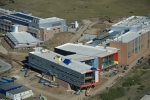
As part of the Better Buildings Challenge, partners commit to reducing energy use in their buildings by 20 percent or more by 2020 and highlighting a project that showcases their commitment to energy efficiency. Check out the map to learn more about partners' showcase projects in your state and their overall Challenge commitments.
New technologies could change the way troops stay cool and warm on the battlefield -- and save energy and money for the military along the way.
BPA recently became the first federal agency in Portland, Oregon, to achieve the city's Sustainability at Work Gold Certification for sustainability efforts at its headquarters building.
Market leaders across the country are driving greater energy efficiency, and the ingenuity they are using is saving them hundreds of thousands of dollars.
The building’s efficient design is expected to result in an energy cost savings of more than 70 percent over the life of the facility.





























